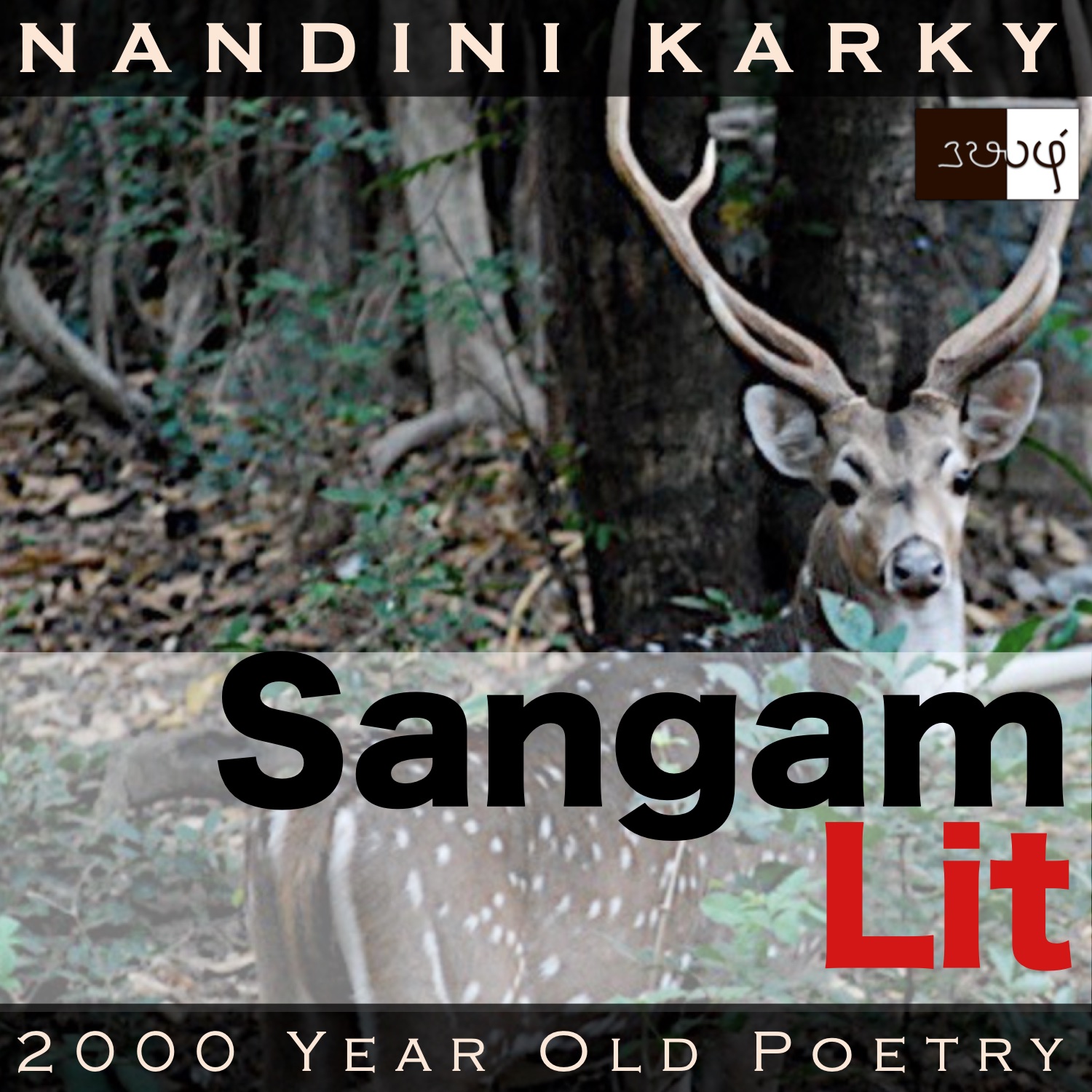Podcast: Play in new window | Download
Subscribe: Apple Podcasts | Spotify | Amazon Music | Android | iHeartRadio | TuneIn | RSS | More

In this episode, we see the blooming of flowers on a rainy morning and listen to the beating heart of a man rushing home, as portrayed in Sangam Literary work, Natrinai 242, penned by Vilikatpethai Perunkannanaar. Set in the forest country of ‘Mullai’, the verse speaks in the voice of the man to his charioteer, bidding him to rush homeward!
இலை இல பிடவம் ஈர் மலர் அரும்ப,
புதல் இவர் தளவம் பூங் கொடி அவிழ,
பொன் எனக் கொன்றை மலர, மணி எனப்
பல் மலர் காயாங் குறுஞ் சினை கஞல,
கார் தொடங்கின்றே காலை; வல் விரைந்து
செல்க-பாக!-நின் தேரே: உவக்காண்-
கழிப் பெயர் களரில் போகிய மட மான்
விழிக் கட் பேதையொடு இனன் இரிந்து ஓட,
காமர் நெஞ்சமொடு அகலா,
தேடூஉ நின்ற இரலை ஏறே.
Opening with ‘இலை இல பிடவம்’ meaning ‘wild jasmine, bereft of leaves’, the poem portrays the harshness of the past season, a hot summer that has dried-up the leaves of the plant. In addition to the ‘பிடவம்’, we get to relish ‘தளவம்’ or ‘pink jasmine’, ‘கொன்றை’ or ‘golden shower’ and ‘காயா’ or ‘ironwood’, trees in various stages of flowering. These stages of flowering are marked by the words ‘மலர் அரும்ப’ meaning ‘buds open’, ‘பூங் கொடி அவிழ’ meaning ‘creepers burst into flowers’, ‘மலர’ meaning ‘blossom’ and a new word ‘கஞல’ meaning ‘decorate’, presenting us with a verbal bouquet of flowers. The reason all this is happening is revealed by the phrase ‘கார் தொடங்கின்றே காலை’ meaning ‘now is the time of the rainy season’. The command ‘வல் விரைந்து செல்க’ meaning ‘hasten your horses’ establishes the core of this verse. After the floral exhibit, our eyes are invited to glance at ‘மட மான்’ meaning ‘naive female deer’ and the young one denoted by the phrase ‘விழிக் கட் பேதை’ meaning ‘young one with startled eyes’. Not just the fawn thus described, but even the poet who penned this expression has come to be called so! The verse ends with ‘தேடூஉ நின்ற இரலை ஏறே’ meaning ‘the male deer that stood searching’. Let us peer into the poem to see more!
The man and lady had been leading a happy, married life when the man had to part away to go on a mission. Before he leaves, the man promises the lady that he would be back before the rainy season. The man completes his mission and as he starts his journey homeward, he turns to his charioteer and says, “Moist flowers of the leafless ‘pidavam’ blossom; slender creepers of the ‘thalavam’, which spreads on bushes, buds open; gold of the ‘kondrai’ blooms; sapphire-hued flowers decorate the small branches of the ‘kaya’ tree; The rainy season has begun. Ride your chariot speedily, O charioteer. Look over there! In that marshland, the female deer and the young one having startled eyes, run in a direction different from their herd. Seeing its mate run thus, the male deer, moved by its loving heart, unable to move, stands searching for its beloved!” With these words, the man expresses the yearning in his heart and propels his charioteer to take him home speedily.
Now, to take a deeper look! The man starts his conversation by talking about the moist ‘pidavam’ flowers opening their buds and covering that leafless bush in a dazzling white. Then, the man mentions the ‘thalavam’, remarking that these bushes have buds spreading out. Thus, the pink jasmine paints with a gentle brush on those bushes. Then comes the ‘kondrai’ tree that seems to blossom with the yellow shower of gold coins. To complete the colourful scene, the ‘kaya’ tree also opens out its flowers and we see a stunning blue spreading mist-like on the tiny branches of the tree. What a visual delight! The words seem to transport us to an ancient grove and fill our senses with the purity of life blooming. After mentioning these flowers, the man talks about the reason they have come alive. It’s the season of rains! For only the rain can nudge the life out of these trees that have been wilting under the sweltering summer heat! The flowers tell the man the rainy season is here and remind him of his promise to the lady. Won’t she feel anxious that the man is still not by her side? As if responding to this question, the man instructs his charioteer to hasten the chariot, so as to spare the lady any more sadness!
To drive home his yearning, the man brings up another scene in the forest. He asks his charioteer to glance in the direction of a herd of deer. A doe and its fawn seem to be running, in a direction opposite to that of the herd. And there, stands a buck confused. What is stopping it from running along with its herd as it would normally do? Although it wants to, its affectionate heart is arresting its movement and there, it stands still, searching for its mate and young one. The man thus transfers the urge in his heart to reunite with his wife and child onto this family of deer in that forest. Words that tell us that the stories of our life will echo out aloud from elements of nature, if we care to listen!




Nicely explained . I enjoyed reading it.
Is there a book you suggest to understand the meanings of these sangam words?
Thank you. Glad you liked it. I would recommend online dictionaries such as Karefo’s Chol (https://karky.in/karefo/labs/chol/chol.html) if you are interested in knowing the meaning of specific Tamil words.